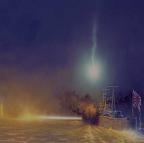stockwellpete
Posts: 582
Joined: 12/20/2012
Status: offline

|
quote:
ORIGINAL: MVP7
Considering the scale of the game I think the most accurate description would be the concentration of artillery including stockpiling of ammunition and high level of planning/coordination.
The typical Corps sized infantry force that occupies a single square in SC:WW1 would have both light and heavy artillery with it. No "hex" would be manned just by infantry and light artillery without any heavy artillery, air elements or cavalry. Units like Detachments and Garrisons are relatively weak on offense and I assume that is because they have relatively small amount of artillery compared to Corps sized units.
Thanks for the reply.
I do not know a great deal about this subject but I have just started to look at how the UK organised its artillery in WW1. In the game they can have a maximum of 4 artillery pieces, which is the same as the Germans. If you look at the numbers of guns indicated from that short You Tube documentary based on Zabecki's book that I posted earlier today then that parity is somewhat surprising. From what I can make of it from various Wikipedia articles, the main British guns in WW1 were the 13 pounders, the 18 pounders and the 4.5 inch Howitzer. Then there were a smaller number of much bigger guns including the 60 pounder.
The 13pdrs were used by the Royal Horse Artillery and were not very effective against trenches and I presume these are not represented separately in the game, but are included in the firepower of the Cavalry units. Cavalry do not de-entrench when they attack as far as I can tell.
The 18pdrs were the main field gun used by the British in the war and they were allocated to infantry divisions rather than being deployed separately - 3 brigades of 18pdrs (54 guns) with 1 brigade of 4.5 howitzers (18 guns) and a single battery of 60 pdrs (4 guns).
However, there were not enough guns to fully equip "Kitchener's army" at first and the batteries had only 4 guns instead of 6. Then there seems to have been a major re-organisation at the start of 1917 and some of the guns were taken away from the infantry divisions and given to something called the Army Field Artillery Brigades, which seemed to have allowed separate and more flexible deployment.
So what is confusing me at the moment is how these 18pdrs and 4.5 howitzers are represented in the game. When an infantry Corps attacks an entrenched enemy it always seems to de-entrench the enemy one level each attack. So that would suggest to me that the field artillery (18pdrs definitely and maybe the 4.5 howitzers as well) are included in the infantry Corps units. But, if that is true, what are these 4 separate Artillery units the British can have meant to represent? The 60pdrs and the very large howitzers? I don't think there were enough of them to warrant 4 artillery units and they do not seem to have been deployed separately until early 1917. If, on the other hand, the 4 Artillery units are meant to represent the 18pdrs and the 4.5 howitzers as well as the heavier guns then why do infantry Corps de-entrench every time they make an attack?
The other thing that is confusing me is when I asked a question about how an Italian infantry Corps unit could sink a Dreadnought in a Port hex, I was told that the infantry Corps would have had field artillery with it. I have noot looked at Italian Artillery yet but they can have 2 Artillery units in the game. Maybe they didn't have enough heavy guns to warrant this separate representation either.
quote:
As a historical example, at battle of St. Quentin Canal in September 1918 the Entente forces started an assault on German line with "56 hour" artillery bombardment. The British has amassed over 1600 artillery pieces (1,044 field guns and 593 heavy guns and howitzers) for a 10.000 yard long front, which fired almost a million shells during the last 24 hours of the bombardment. That heavy gun concentration is still not even close to the total amount of guns the British had, but the number of involved guns, the prepared stockpile of ammunition, and the degree on preliminary planning was obviously well beyond the normal level.
The advancement in artillery technology and doctrine at St. Question was also obvious. At the start of the war in 1914 the artillery was largely light direct fire support with the larger "siege" guns rare and underdeveloped. The artillery shell consumption had been severely underestimated resulting to stuff like the 1915 Shell Crisis.
At battle of Somme in 1916 the massive Entente artillery bombardment of over 1,6 million shells failed to destroy the German fortification (apparently they used shrapnel shells among other mistakes). The tech and doctrine had improved significantly but were far from perfect.
However at St. Quentin the well planned bombardment included special fuses for destroying the barbed wire, gas shells for hitting the enemy artillery, supply and HQ units, as well as creeping barrages to support the infantry assault. All that allowed the Entente to break through the Hindenburg line with relative ease. I think it's safe to say that in the end it was the artillery that won the battle and the war (on the battlefields at least).
This kind of well prepared large artillery operation is what I assume the in-game artillery "unit" represents, rather than just a literal collection on guns. With slowed down development of artillery in the latest patch of SC:WW1 the pace of artillery development seems to better match the historical course, although the research of ammo production could be still be slower for it to be maxed closer to the end of war.
OK, I can see your reasoning here, but I am not sure the British were capable of delivering this sort of attack for most of the war. I might be completely wrong though.
quote:
The maximum amount of ammo per artillery unit could be slightly lower because two artillery units can still neuter any fortification in the game from full strength in a single turn without any input from the defender before the attacker can take over with minimal losses. At St. Quentin Canal it doesn't seem like the Entente had any massive advantage in the numbers of infantry but they still won (which is pretty remarkable considering the losses the attacker would typically suffered just couple years earlier). Even though they won, they still suffered about 24,000 casualties to the Germany's 36,000. That is far more relative casualties than you will typically suffer taking a hex after a (fully upgraded) artillery preparation in-game.
Yes, either the ammo has to be reduced (a maximum of 6 seemed to work OK in the one play-test I did before the latest patch) or the number of artillery units has to be reduced. This will depend on (using the British example) whether the 18pdr is said to be part of an infantry Corps, or deployed separately. If deployed separately then infantry Corps should not de-entrench every time they attack.
quote:
If I have understood correctly, the different types of artillery units in SC:WW1 exist for use in smaller scale scenarios where differentiating between artillery types actually makes sense (i.e. "Move this heavy artillery brigade from this village to that field"). On strategic scale you are not really going to say "Lets send all the 155mm guns to Somme and leave nothing but 75mm to the rest of the front". At strategic level the artillery will move and operate as a part of larger formations and at most you will have a relatively high concentration of well prepared and organized heavy artillery at specific part of the the front, rather than permanently independent massive artillery formations with exclusively big guns moving around freely.
OK, I have only played the main campaign so far.
< Message edited by stockwellpete -- 12/13/2020 8:40:55 PM >
|
 Printable Version
Printable Version










 New Messages
New Messages No New Messages
No New Messages Hot Topic w/ New Messages
Hot Topic w/ New Messages Hot Topic w/o New Messages
Hot Topic w/o New Messages Locked w/ New Messages
Locked w/ New Messages Locked w/o New Messages
Locked w/o New Messages Post New Thread
Post New Thread